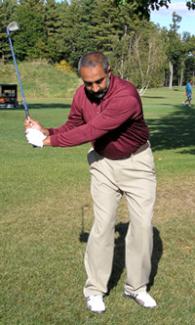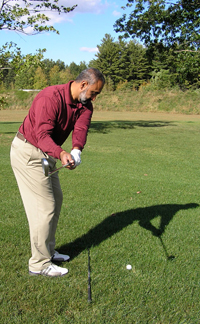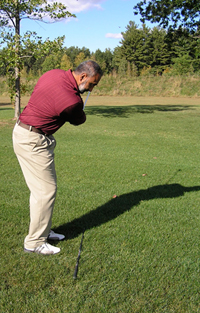Featured Golf News
Improve Your Pitch Shots

Pitching Photo 1
In a pitch shot, the ball gains quick height and lands softly on the green with hardly any run after it lands. A wedge (preferably a more lofted one such as a sand or lob wedge) gives best results for this shot.

Pitching Photo 2
Problem
You experience neither distance nor directional control.
Probable Cause
An open stance, a wristy backswing which starts 'out' and/or a follow-through in which the body stands up out of posture, and, simultaneously, rotates so that the club gets pulled "up" and "in" resulting in thin shots that go left or right. See photos 1 and 2.

Pitching Photo 3
Solution
Set-up
At address, the right shoulder should be slightly behind the left and the stance should be 'square' with the feet parallel to the target line. See photo 3.
Swing
In order to impart height to the ball, the arms and club shaft should describe a "Ferris-wheel" motion practically on a vertical plane through the golf ball. The desired steepness of the backswing should be created by bending the right elbow, not the wrists.
In the backswing, swing until the left arm and club are in a completely horizontal line, from shoulder to clubhead, with the right elbow slightly bent. See photo 4.

Pitching Photo 4
Swing past the ball until the right arm is fairly straight, and the left elbow slightly bent, but with NO turn of the body as the club passes the ball. See photo 5.
Minimalist Golf Swing Rationale
During set-up, if the right shoulder is slightly behind the left, it ensures that the swing does not start "out." NO swing in golf should ever commence away from the target line (i.e., "out").

Pitching Photo 5
To further encourage a very slightly "inside" backswing path, the feet and hips should be parallel to the target line. The old concept of an open stance with an out-to-in path is not a reliable one, as the body might move into all sorts of un-necessary positions to achieve this.
Backswing steepness should be created from right elbow - and not the right wrist-fold because elbow-fold gives more margins for error; a bent wrist can straighten out too early or too late and results in more inconsistency. In fact, the more the thumbs face down instead of up, more backspin can be created for this type of shot.
There should be no rotation of the body, especially in the follow-through, as this reduces the required steepness. Keeping the nose facing forwards past impact helps prevent body rotation.
Drills/Exercise
Practice the movement with the feet together, just working on an up-down-and-up movement with "straight left arm then straight right arm." Also, the right-elbow fold during the backswing must always be with the elbow pointing downwards and not backwards.
The above photos are of Rusty Gill, a 2008 World Long Drive participant in the Senior Division.
Kiran Kanwar has 20 years experience as a golf instructor. She currently teaches golf in St. Louis, Mo., and in Bombay, India. At the 2008 PGA Merchandise Show Kiran exhibited a research-based golf swing that quickly gave players of any skill level better distance, direction and trajectory. She also has expertise in dramatically and rapidly increasing a golfer's swing-efficiency to preclude swing-related injury. She's a Class A teaching professional with credentials from the LPGA, the PGA (UK), the PGA of India, and the National Golf Academy of India. Among other titles, Kanwar won the Ladies All-India Open Amateur Golf Championship in 1983. A columnist for Golf Digest India, Kiran is the author of an instructional e-book - sold on her website - entitled "DIY (Do-It-Yourself) GOLF." For more information visit www.yourgolfguru.com or email her at kk@yourgolfguru.com.
Story Options
 |
Print this Story |
